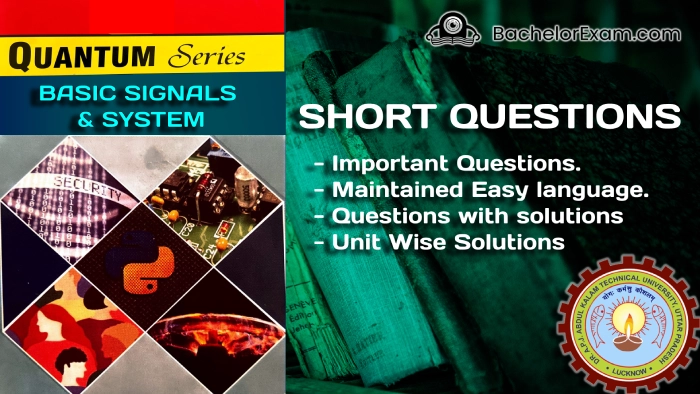Here we are providing the last year question paper for Basic Signals and Systems – 2021-22 AKTU with solutions. I hope this article helps you in your upcoming exams.
Dudes 🤔.. You want more useful details regarding this subject. Please keep in mind this as well. Important Questions For Basic Signals and Systems : *Unit-01 *Unit-02 *Unit-03 *Unit-04 *Unit-05 *Short-Q/Ans *Question-Paper with solution 21-22
Section A: Short Question in Basic Signals and Systems
a. Define CT signals.
Ans. Continuous-time (CT) signals are those that are defined for every instant of time.
b. Define unit step, ramp and delta functions for CT.
Ans.
1. Unit step: It is defined as
2. Unit ramp: It is defined as
3. Unit impulse (Delta function): It is defined as
c. Define odd and even signal.
Ans. A continuous-time signal x(t) is said to be even if
x(-t) = x(t) ; for all t
x(t) is said to be odd if
x(-t) = -x(t) ; for all t
d. Define linear and non-linear systems.
Ans. A. Linear system : A linear system is one that complies with the superposition and homogeneity principles.
B. Non-linear system: A non-linear system is one that deviates from the superposition and homogeneity principles.
e. Define time invariant and time varying systems.
Ans. A. Time invariant system: A system is considered time invariant if its input/output properties do not alter over time.
B. Time varying system: If a system’s input/output properties fluctuate with time, it is said to be time varying.
f. Define static and dynamic system.
Ans. A. Static system: If a system responds solely to current input, it is said to be static.
B. Dynamic system: If a system’s response is based on current or historical inputs, it is said to be dynamic.
g. Check whether the given system is causal and stable
y(n) = 3x(n – 2) + 3x(n + 2).
Ans. Since y(n) depends upon x(n + 2), this system is noncausal. As long as x(n-2) and x(n +2) are bounded, the output y(n) will be bounded. Hence this system is stable.
h. What is the Laplace transform of e-at sin ωt u(t) ?
Ans.
i. A signal x(t) = cos 2兀 ft is passed through a device whose input-output is related by y(t) = x2 (t). What are the frequency components in the output ?
Ans.
The frequency components at the output are 0 Hz (i.e., DC) and 2f Hz.
j. Define the Fourier transform pair for continuous time signal.
Ans. Fourier transform:
Inverse Fourier transform:
Section B: Important Long Questions Paper With Solutions.
a. i. Obtain the Fourier transform of x(t) = e-atu(t), a > 0.
ii. Find the Laplace transform of signal u(t).
iii. Find the Laplace transform of the signal.
x(t) = – te-2t u(t)
iv. List some properties of continuous-time Fourier transform
Ans. i. Obtain the Fourier transform of x(t) = e-atu(t), a > 0.
ii.Laplace transform of signal u(t).
iii. Laplace transform of the signal x(t) = – te-2t u(t)
iv. Properties of fourier transform :
- 1. Duality
- 2. Time shifting
- 3. Frequency shifting
- 4. Scaling
- 5. Linearity
- 6. Time differentiation
- 7. Time integration
b. i. What are the properties of convolution ?
ii. Find the unit step response of the system given by
h(t) = (1/RC).e-t/RC u(t)
Ans. i. Properties of convolution:
1. Commutative property: The commutative property of convolution states that
2. Distributive property: The distributive property of convolution states that
3. Associative property: The associative property of convolution states that
4. Shift property: The shift property of convolution states that
5. Convolution with an impulse: Convolution of a signal x(t) with a unit impulse is the signal itself, i.e.,
6. Width property: Let the duration of x1(t) and x2(t) be T1 and T2 respectively. Then the duration of the signal obtained by convolving x1(t) and x2(t) is T1 +T2.
7. Differentiation property:
According to the differentiation property,
8. Time-scaling property:
ii. Numerical:
1. h(t) = (1/RC).e-t/RC u(t)
2. The step response can be obtained from impulse response as
c. i. What is the transfer function of a system whose poles are at – 0.3 ± j 0.4 and a zero at – 0.2 ?
ii. Give the Existence of DTFT.
Ans. i. Transfer function of a system :
1. Poles are at Z= -0.3 ± j0.4,
2. Denominator polynomial
= Z-[-0.3 + j0.4)] [Z -(-0.3 – j.04)]
3. Zero at Z = -0.2
4. Numerator polynomial
= Z + 0.2
5. The transfer function is given by
ii. Existence of DTFT: Since the DTFT is given as
The X(Ω) can exist only if x[n] is absolutely summable.
d. Calculate the initial and final values of the functions x1(t), x2(t), whose Laplace transforms are specified below:
Ans.
e. i. What do you mean by state transition matrix ? State and prove its properties.
ii. State and prove time shifting and differentiation properties of Z-transform.
Ans. i. A. Initial value theorem: The initial value theorem of Z-transform states that, for a causal signal x [n]
Proof:
1. For a causal signal
2. Taking the limit z → ∞ on both sides, we have
3. This theorem helps us to find the initial value of x[n] from X(z) without taking its inverse Z-transform.
B. Final value Theorem: For a causal signal, the Z-ultimate transform’s value theorem asserts that.
and if X(z) has no poles outside the unit circle, and it has no double or higher order poles on the unit circle centered at the origin of the z-plane, then
Proof:
1. For a causal signal
5. This theorem enables us to find the steady-state value of x[n], i.e. x(∞) without taking the inverse Z-transform of X(z).
ii. A. Time shifting property:
B. Differentiation property:
Section C : Question with solution in Basic Signals and Systems
a. Determine if systems with the following impulse responses:
i. h(t) = δ(t- 2),
ii. h(t) = δ(t) – δ(t – 2), are invertible.
Ans. i. h(t) = δ(t- 2)
A system is called invertible if it produces distinct output signals for distinct input signals
So the given system is invertible.
ii. h(t) = δ(t) – δ(t – 2)
So the given system is invertible.
b. Calculate the inverse Laplace transform of right-sided sequences with the following transfer functions :
Ans.
Part 2 : Important Question in Choice (Attempt only One)
a. Calculate the unilateral Laplace transform for the following functions:
i. Unit impulse function, x1 (t) = δ(t);
ii. Unit step function, x2 (t) = u(t)
Ans. i. Unit impulse: δ(t)
ii. Unit Step: u(t)
b. Calculate the Fourier transform of the following functions :
i. Unit impulse sequence,x1[k] = δ[k];
ii. Decaying exponential sequence, x3[k] = pku[k] with |p| < 1.
Ans. i. Unit impulse sequence:
ii. Decaying exponential sequence:
Part 3: Important Question (Attempt any One)
a. Calculate the trigonometric CTFS coefficients of the periodic signal x(t) defined over one period T0= 3 as follows :
Ans. 1.Since x(t) has a fundamental period, T0 =3 and fundamental frequency,
b. Calculate the CTFS coefficients for the following signal.
Ans. 1.
2. Rewriting the given equation in terms of complex exponentials.
4. Thus, the fourier series coefficient for this x(t) are,
Part 4. Attempt any one following question
a. Consider the system
Determine (i) the impulse response (ii) the zero-state step response.
Ans.
b. A signal has Laplace transform
Find the Laplace transform Y(s), of the following signals
i. y(t) = tx(t)
ii. y(t) = e-t x(t)
Ans.
Part 5. Attempt any one
a. For the given mechanical system draw the equivalent circuit using F-V and F-I analogy.
Ans. 1. Mechanical equivalent circuit :
b. What do you mean by the existence of Fourier series ? And explain properties of Fourier series.
Ans. A. Existence of Fourier series (Dirichlet’s condition):
- 1. Dirichlet’s conditions are the circumstances in which a periodic signal can be represented by a Fourier series.
- 2. They are as follows:
- i. The function x(t) must only have one value.
- ii. Only a finite number of maxima and minima exist for the function x(t).
- iii. There are a finite number of discontinuities in the function x(t).
- iv. The function x(t) is absolutely integrable over one period, that is
B. Properties of Fourier series:
1. Linearity property:
The linearity property states that, if
2. Time shifting property:
The time shifting property states that, if
3. Time reversal property:
The time reversal property states that, if
4. Time scaling property:
The time scaling property states that, if
5. Time differentiation property:
The time differentiation property states that, if
6. Time integration property:
The time integration property states that,if



Important Question with solutions | AKTU Quantums | Syllabus | Short Questions
Basic Signal And System Quantum, Syllabus, Important Questions
| Label | Link |
|---|---|
| Subject Syllabus | Syllabus |
| Short Questions | Short-question |
| Important Unit-1 | Unit-1 |
| Important Unit-2 | Unit-2 |
| Important Unit-3 | Unit-3 |
| Important Unit-4 | Unit-4 |
| Important Unit-5 | Unit-5 |
| Question paper – 2021-22 | 2021-22 |
Basic Signal And System Quantum PDF: | AKTU Quantum PDF:
| Quantum Series | Links |
| Quantum -2022-23 | 2022-23 |
AKTU Important Links | Btech Syllabus
| Link Name | Links |
|---|---|
| Btech AKTU Circulars | Links |
| Btech AKTU Syllabus | Links |
| Btech AKTU Student Dashboard | Student Dashboard |
| AKTU RESULT (One VIew) | Student Result |

2 thoughts on “Question Paper Basic Signals and Systems – 2021-22 AKTU with solutions.”